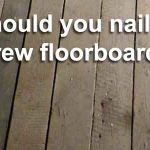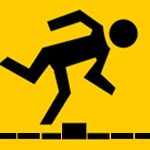Whether you are fitting new floorboards or replacing existing ones, one thing you should consider is the size of the boards. This is especially true if you are matching the new boards to existing flooring.
Floorboards tend to come in a few different sizes. The two most common sawn thickness will be roughly 1inch and ¾ inch (19 & 25mm). However, these are the sawn sizes, once the boards are planed and finished, they will come in at between 18mm and 22mm. The thickness can vary depending on where you buy from.
For board widths, you are generally going to find sawn sizes of roughly 5 & 6 inch (125mm & 150mm) with finished sizes between 119mm and 144mm.
Lengths can range between 1.8m all the way up to 5.6m
The metric to imperial measurements mentioned here, will not match exactly. Timber in the UK is measured and cut using the metric system. However, many people in the trade will talk in imperial or a combination of the two.
You will find this much more in builders’ merchants and timber yards, as well as on building sites. However, if you visit somewhere like Wickes or B&Q, everything will be in metric (mm). This can be a little confusing, but going to a proper timber yard will usually mean a better-quality product and lower prices.
Essentially, if you want to save money and buy better quality boards, then buying from a builders/timber merchant is usually the best choice. Just make sure you measure up before you go and ask them what the finished size of the boards is.
Fitting to old floorboards

As we already mentioned modern floorboards come in a few different widths and thicknesses. The same is true for old floorboards. Annoyingly, they rarely come in exactly the same sizes. Older boards tend to use the imperial system and they were finished slightly differently.
Common thicknesses often range between 19 & 21mm (¾ inch & ⅞ inch) and widths of between 112mm and 157mm (4 ½ inch and 6 ¼ inch).
There are some timber merchants out there who provide old sizes like these. However, they are far less common and tend to be considerably more expensive. You also have the option of buying old, reclaimed boards, but again this is not as readily available.
More often than not, you will need to find the closest match and make it fit. Generally, a 1mm difference in thickness won’t make much difference, especially if the floor will have underlay and carpet fitted.
For board width, again you should be able to find something similar. For boards that are slightly wider you can usually just rip/plane the tongue off, and this will be enough to make it fit.
Solutions for wider boards that are not available
For any boards that are wider than standard modern boards, such as 6 ¼ inch (157mm) the gap may be slightly too big. If this is the case, you either need to source the correct size boards, or use something else such as plywood, or even a piece of timber machined too the correct size.
If your plan is to leave the floor exposed and you need timber boards, then a good timber yard will usually machine a piece of timber for you. They will be able to do this to the correct width and thickness. Obviously, this will not have a tongue and groove, and you will also need to pay a little extra. However, if the finish is important and you are dealing with wide boards, it is often the best solution, unless you can source replacement boards.
If you are carpeting over and the floorboards won’t be seen, then you can just rip down a piece of ¾ inch plywood and fit. This will usually be about the right thickness. Occasionally with ⅞ boards there may be a slight lip where the boards are a little higher than the ply. This is not going to be very noticeable once the carpets are down.
Also, you can easily make this 100% level, by simply packing the joists with some plastic packers.
Another option for replacing floorboards
If you are planning to replace a lot of floorboards, maybe even all of them, another option is to use tongue and groove chipboard flooring. This type of flooring comes in 18mm and 22mm thickness and sheets are 2400mm x 600mm (approximately 8×2 feet) per board.
This can be a really quick and cheap alternative to timber floorboards. The boards themselves, are 4-5 times as wide as a standard timber floorboard, so this makes them much easier to fit, as there is far less cutting involved. Plus, you can cover a larger area much quicker and it tends to be cheaper per m2 than timber floorboards.
Get help replacing your floorboards
If you do need help with your floorboards, then a good local joiner, will be able to take care of this quite easily.
Its not an overly complicated job, so you should be able to get a good rate by comparing a few quotes. The best way to do this is online via a trade comparison site. They get you quotes from local businesses in your area, and this means prices tend to be far lower. Plus, you are able to read all their past customer reviews.
Even if you were planning to do the work yourself, it’s often a good idea to see how much it would cost from a professional. Often, you will find the discounted rate from a comparison site, is much more attractive than doing the work yourself.
Conclusion
Floorboards are not one standard size, but they do come in a standard range of sizes. This can vary slightly depending on where you buy them. However, they are usually quite close.
With that said, old floorboards come in a slightly different range of sizes. Therefore, finding an exact match can be a challenge. The best advice is to measure the existing boards and then shop around to find the best match.
When you do this, you should be able to find pretty close matches. Although some boards may need a little plane of the edges to make them fit. You may also need to use packers to get a nice level finish on the tops of your boards.




